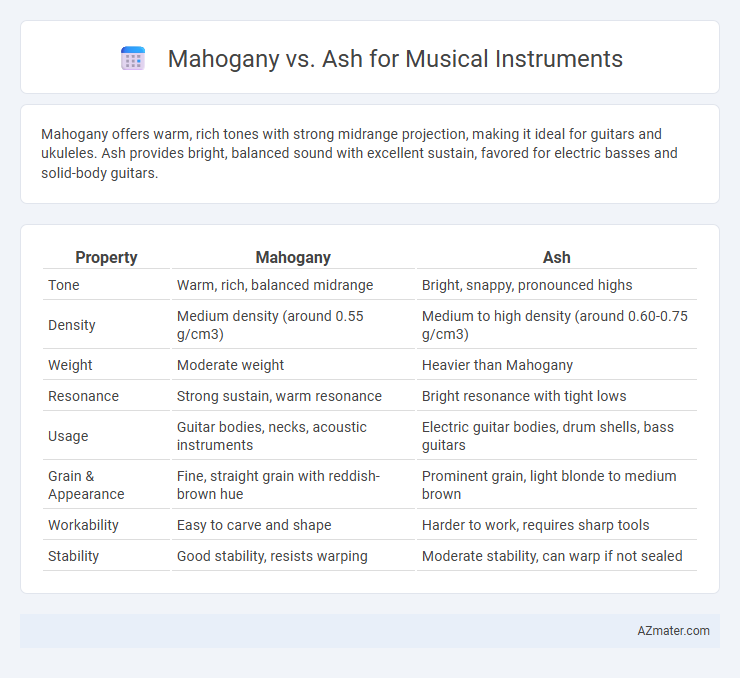Mahogany offers warm, rich tones with strong midrange projection, making it ideal for guitars and ukuleles. Ash provides bright, balanced sound with excellent sustain, favored for electric basses and solid-body guitars.
Table of Comparison
| Property | Mahogany | Ash |
|---|---|---|
| Tone | Warm, rich, balanced midrange | Bright, snappy, pronounced highs |
| Density | Medium density (around 0.55 g/cm3) | Medium to high density (around 0.60-0.75 g/cm3) |
| Weight | Moderate weight | Heavier than Mahogany |
| Resonance | Strong sustain, warm resonance | Bright resonance with tight lows |
| Usage | Guitar bodies, necks, acoustic instruments | Electric guitar bodies, drum shells, bass guitars |
| Grain & Appearance | Fine, straight grain with reddish-brown hue | Prominent grain, light blonde to medium brown |
| Workability | Easy to carve and shape | Harder to work, requires sharp tools |
| Stability | Good stability, resists warping | Moderate stability, can warp if not sealed |
Introduction to Mahogany and Ash in Musical Instruments
Mahogany offers a warm, rich tone with excellent sustain, making it a favorite wood choice for guitar bodies and necks, valued for its density and stability. Ash provides a brighter, snappier sound with strong midrange presence and natural resonance, often favored in electric guitar bodies for its lightweight and attractive grain patterns. Both woods significantly influence the tonal qualities and playability of musical instruments, making them essential options for luthiers and musicians seeking distinct sound characteristics.
Historical Use of Mahogany and Ash
Mahogany has been historically prized in musical instrument construction for its rich, warm tone and exceptional resonance, prominently used in classic acoustic guitars and high-quality solid-body electric guitars since the 19th century. Ash gained popularity in the mid-20th century, valued for its bright sound and strong grain patterns, often featured in iconic electric guitars like the Fender Telecaster and Stratocaster. Both woods have shaped the tonal characteristics and aesthetic appeal of musical instruments, with mahogany offering depth and warmth, while ash provides clarity and brightness.
Tonewood Characteristics: Mahogany vs Ash
Mahogany offers a warm, rich tone with pronounced midrange and smooth sustain, making it ideal for rhythm playing and blues styles in musical instruments. Ash provides a bright, snappy sound with strong, articulate highs and enhanced low-end punch, favored for genres requiring clarity and dynamic response. Both tonewoods balance weight and durability, but mahogany's porous grain delivers a mellower resonance compared to ash's tighter grain that yields more attack and brightness.
Sound Profile Comparison
Mahogany produces a warm, rich tone with pronounced midrange frequencies and smooth sustain, making it ideal for blues and folk instruments. Ash offers a brighter sound characterized by strong attack, clear highs, and balanced lows, favored in genres requiring crisp articulation and punch. Choosing between mahogany and ash depends on the desired tonal emphasis, with mahogany enhancing warmth and ash providing clarity and snap.
Weight and Durability Differences
Mahogany is denser and heavier than ash, providing a solid, warm tone favored in guitars and drums, while ash is lighter, making it easier to handle and preferred for instruments requiring greater mobility. Ash offers excellent durability with a strong, flexible grain structure that resists dents and cracks, whereas mahogany, though durable, is more prone to surface scratches due to its softer nature. The weight difference significantly impacts instrument comfort and playability, with mahogany's heft enhancing sustain and ash's lightness improving ergonomic balance.
Mahogany vs Ash: Guitar Bodies
Mahogany guitar bodies deliver warm, rich tones with strong midrange emphasis and excellent sustain, making them favored for blues and rock genres. Ash guitar bodies offer bright, snappy sounds with pronounced highs and a strong attack, ideal for clean, sharp tones commonly used in country and funk music. Weight differences also affect playability, as ash tends to be heavier and more resonant while mahogany is typically lighter and more comfortable for extended play.
Mahogany vs Ash: Drum Shells
Mahogany drum shells offer warm, rich tones with enhanced midrange frequencies, making them ideal for genres requiring deep, full-bodied sound. Ash drum shells provide bright, punchy attack with pronounced highs and clear projection, favored in styles needing sharp, articulate beats. The choice between mahogany and ash shells significantly impacts tonal character, sustain, and overall drum resonance.
Cost and Availability
Mahogany tends to be more expensive than ash due to its denser grain and popularity in high-end musical instruments, making it a premium choice for guitars and drums. Ash is generally more affordable and widely available, commercially sourced from North American forests, which ensures steadier supply and lower cost. The price difference impacts production budgets, with ash favored in budget to mid-range instruments while mahogany is preferred for its tonal warmth in professional models.
Choosing the Right Wood for Your Playing Style
Mahogany offers warm, rich tones with strong midrange frequencies, making it ideal for blues and jazz musicians seeking depth and resonance in their sound. Ash provides bright, balanced tones with pronounced highs and a tight low end, preferred by rock and country players who value clarity and punch. Selecting the right wood depends on your playing style: choose mahogany for warmth and sustain, or ash for brightness and attack.
Conclusion: Which is Better for Your Music?
Mahogany offers a warm, rich tone with enhanced midrange frequencies ideal for blues and jazz styles, while ash provides bright, clear sound with strong attack suitable for rock and country genres. The choice depends on your tonal preference and playing style, with mahogany delivering smoother, mellower sounds and ash producing more defined, resonant notes. Musicians seeking versatility and a balanced tone might lean towards mahogany, whereas those wanting punchier, brighter tones often prefer ash for their instruments.

Infographic: Mahogany vs Ash for Musical Instrument
 azmater.com
azmater.com